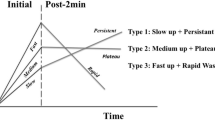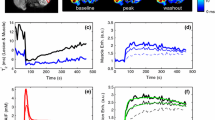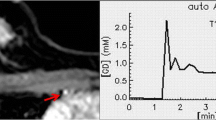Abstract
Objectives
X-ray iodinated contrast media have been shown to generate contrast in MR images when used with the chemical exchange saturation transfer (CEST) approach. The aim of this study is to compare contrast enhancement (CE) capabilities and perfusion estimates between radiographic molecules and a Gd-based contrast agent in two tumour murine models with different vascularization patterns.
Methods
MRI-CEST and MRI-CE T1w images were acquired in murine TS/A and 4 T1 breast tumours upon sequential i.v. injection of iodinated contrast media (iodixanol, iohexol, and iopamidol) and of gadoteridol. The signal enhancements observed in the two acquisition modalities were evaluated using Pearson’s correlation, and the correspondence in the spatial distribution was assessed by a voxelwise comparison.
Results
A significant, positive correlation was observed between iodinated contrast media and gadoteridol for tumour contrast enhancement and perfusion values for both tumour models (r = 0.51-0.62). High spatial correlations were observed in perfusion maps between iodinated molecules and gadoteridol (r = 0.68-0.86). Tumour parametric maps derived by iodinated contrast media and gadoteridol showed high spatial similarities.
Conclusions
A good to strong spatial correlation between tumour perfusion parameters derived from MRI-CEST and MRI-CE modalities indicates that the two procedures provide similar information.
Key Points
• Gd-based agents are the standard of reference for contrast-enhanced MRI.
• Iodinated contrast media provides MRI-CEST contrast enhancement in animal tumour models.
• Contrast enhancements were positively correlated between iodinated agents and gadoteridol.
• Tumour perfusion map showed similar spatial distribution between iodinated agents and gadoteridol.
• MRI-CEST with iodinated agents provide similar information to gadoteridol.






Similar content being viewed by others
Abbreviations
- CAs:
-
Contrast Agents
- CE:
-
Contrast Enhanced
- CEST:
-
Chemical-Exchange Saturation Transfer
- FOV:
-
Field of view
- NSF:
-
Nephrogenic Systemic Fibrosis
- ROI:
-
Region of Interest
References
Hylton N (2006) Dynamic contrast-enhanced magnetic resonance imaging as an imaging biomarker. J Clin Oncol 24:3293–3298
Dawson P (2006) Functional imaging in CT. Eur J Radiol 60:331–340
Miles KA (2002) Functional computed tomography in oncology. Eur J Cancer 38:2079–2084
Winfield JM, Payne GS, deSouza NM (2015) Functional MRI and CT biomarkers in oncology. Eur J Nucl Med Mol Imaging 42:562–578
Morana G, Cugini C, Scatto G, Zanato R, Fusaro M, Dorigo A (2013) Use of contrast agents in oncological imaging: magnetic resonance imaging. Cancer Imaging 13:350–359
Pierre VC, Allen MJ, Caravan P (2014) Contrast agents for MRI: 30+ years and where are we going? J Biol Inorg Chem 19:127–131
Grobner T (2006) Gadolinium--a specific trigger for the development of nephrogenic fibrosing dermopathy and nephrogenic systemic fibrosis? Nephrol Dial Transplant 21:1104–1108
Yang L, Krefting I, Gorovets A et al (2012) Nephrogenic systemic fibrosis and class labeling of gadolinium-based contrast agents by the Food and Drug Administration. Radiology 265:248–253
Thomsen HS, Morcos SK, Almen T et al (2013) Nephrogenic systemic fibrosis and gadolinium-based contrast media: updated ESUR Contrast Medium Safety Committee guidelines. Eur Radiol 23:307–318
Idee JM, Fretellier N, Robic C, Corot C (2014) The role of gadolinium chelates in the mechanism of nephrogenic systemic fibrosis: A critical update. Crit Rev Toxicol 44:895–913
Aime S, Caravan P (2009) Biodistribution of gadolinium-based contrast agents, including gadolinium deposition. J Magn Reson Imaging 30:1259–1267
Kanda T, Ishii K, Kawaguchi H, Kitajima K, Takenaka D (2014) High signal intensity in the dentate nucleus and globus pallidus on unenhanced T1-weighted MR images: relationship with increasing cumulative dose of a gadolinium-based contrast material. Radiology 270:834–841
Quattrocchi CC, Mallio CA, Errante Y et al (2015) Gadodiamide and dentate nucleus T1 hyperintensity in patients with meningioma evaluated by multiple follow-up contrast-enhanced magnetic resonance examinations with no systemic interval therapy. Investig Radiol 50:470–472
Radbruch A, Weberling LD, Kieslich PJ et al (2015) Gadolinium retention in the dentate nucleus and globus pallidus is dependent on the class of contrast agent. Radiology 275:783–791
Halvorsen RA (2008) Which study when? Iodinated contrast-enhanced CT versus gadolinium-enhanced MR Imaging. Radiology 249:9–15
Dawson P, Blomley MJK (1996) Contrast media as extracellular fluid space markers: Adaptation of the central volume theorem. Br J Radiol 69:717–722
van Zijl PC, Yadav NN (2011) Chemical exchange saturation transfer (CEST): what is in a name and what isn't? Magn Reson Med 65:927–948
Vinogradov E, Sherry AD, Lenkinski RE (2013) CEST: from basic principles to applications, challenges and opportunities. J Magn Reson 229:155–172
Liu G, Song X, Chan KW, McMahon MT (2013) Nuts and bolts of chemical exchange saturation transfer MRI. NMR Biomed 26:810–828
Castelli DD, Terreno E, Longo D, Aime S (2013) Nanoparticle-based chemical exchange saturation transfer (CEST) agents. NMR Biomed 26:839–849
Terreno E, Castelli DD, Aime S (2010) Encoding the frequency dependence in MRI contrast media: the emerging class of CEST agents. Contrast Media Mol Imaging 5:78–98
Longo DL, Dastru W, Digilio G et al (2011) Iopamidol as a responsive MRI-chemical exchange saturation transfer contrast agent for pH mapping of kidneys: In vivo studies in mice at 7 T. Magn Reson Med 65:202–211
Aime S, Calabi L, Biondi L et al (2005) Iopamidol: Exploring the potential use of a well-established x-ray contrast agent for MRI. Magn Reson Med 53:830–834
Müller-Lutz A, Khalil N, Schmitt B et al (2014) Pilot study of Iopamidol-based quantitative pH imaging on a clinical 3T MR scanner. MAGMA
Longo DL, Michelotti F, Consolino L et al (2016) In Vitro and in vivo assessment of nonionic iodinated radiographic molecules as chemical exchange saturation transfer magnetic resonance imaging tumor perfusion agents. Invest Radiol 51:155–162
Chen SZ, Yuan J, Deng M, Wei J, Zhou J, Wang YJ (2016) Chemical exchange saturation transfer (CEST) MR technique for in-vivo liver imaging at 3.0 tesla. Eur Radiol 26:1792–800
Li C, Peng S, Wang R et al (2014) Chemical exchange saturation transfer MR imaging of Parkinson's disease at 3 Tesla. Eur Radiol 24:2631–2639
Jiang S, Yu H, Wang X et al (2016) Molecular MRI differentiation between primary central nervous system lymphomas and high-grade gliomas using endogenous protein-based amide proton transfer MR imaging at 3 Tesla. Eur Radiol 26:64–71
Zaiss M, Windschuh J, Goerke S et al (2016) Downfield-NOE-suppressed amide-CEST-MRI at 7 Tesla provides a unique contrast in human glioblastoma. Magn Reson Med
Donahue MJ, Donahue PC, Rane S et al (2016) Assessment of lymphatic impairment and interstitial protein accumulation in patients with breast cancer treatment-related lymphedema using CEST MRI. Magn Reson Med 75:345–355
Cai K, Singh A, Poptani H et al (2015) CEST signal at 2ppm (CEST@2ppm) from Z-spectral fitting correlates with creatine distribution in brain tumor. NMR Biomed 28:1–8
Longo DL, Busato A, Lanzardo S, Antico F, Aime S (2013) Imaging the pH evolution of an acute kidney injury model by means of iopamidol, a MRI-CEST pH-responsive contrast agent. Magn Reson Med 70:859–864
Chen LQ, Howison CM, Jeffery JJ, Robey IF, Kuo PH, Pagel MD (2014) Evaluations of extracellular pH within in vivo tumors using acidoCEST MRI. Magn Reson Med 72:1408–1417
Longo DL, Sun PZ, Consolino L, Michelotti FC, Uggeri F, Aime S (2014) A general MRI-CEST ratiometric approach for pH imaging: demonstration of in vivo pH mapping with lobitridol. J Am Chem Soc 136:14333–14336
Chen LQ, Randtke EA, Jones KM, Moon BF, Howison CM, Pagel MD (2015) Evaluations of tumor acidosis within in vivo tumor models using parametric maps generated with AcidoCEST MRI. Mol Imaging Biol 17:488–96
Jones KM, Randtke EA, Howison CM et al (2015) Measuring extracellular pH in a lung fibrosis model with acidoCEST MRI. Mol Imaging Biol 17:177–184
Terreno E, Stancanello J, Longo D et al (2009) Methods for an improved detection of the MRI-CEST effect. Contrast Media Mol Imaging 4:237–247
Lavini C, Verhoeff JJ, Majoie CB, Stalpers LJ, Richel DJ, Maas M (2011) Model-based, semiquantitative and time intensity curve shape analysis of dynamic contrast-enhanced MRI: a comparison in patients undergoing antiangiogenic treatment for recurrent glioma. J Magn Reson Imaging 34:1303–1312
Holden G (1993) Statistical power analysis for the behavioral-sciences, 2nd edition - cohen. J Soc Work Health Care 18:131–132
Iagaru A, Gambhir SS (2013) Imaging tumor angiogenesis: the road to clinical utility. AJR Am J Roentgenol 201:W183–W191
Brix G, Griebel J, Kiessling F, Wenz F (2010) Tracer kinetic modelling of tumour angiogenesis based on dynamic contrast-enhanced CT and MRI measurements. Eur J Nucl Med Mol Imaging 37:S30–S51
Kim JH, Kim HJ, Lee KH, Kim KH, Lee HL (2004) Solitary pulmonary nodules: a comparative study evaluated with contrast-enhanced dynamic MR imaging and CT. J Comput Assist Tomogr 28:766–775
Kierkels RG, Backes WH, Janssen MH et al (2010) Comparison between perfusion computed tomography and dynamic contrast-enhanced magnetic resonance imaging in rectal cancer. Int J Radiat Oncol Biol Phys 77:400–408
Xu X, Yadav NN, Knutsson L et al (2015) Dynamic glucose-enhanced (DGE) MRI: translation to human scanning and first results in glioma patients. Tomography 1:105–114
Xu X, Chan KW, Knutsson L et al (2015) Dynamic glucose enhanced (DGE) MRI for combined imaging of blood-brain barrier break down and increased blood volume in brain cancer. Magn Reson Med 74:1556–1563
Murakami M, Ernsting MJ, Undzys E, Holwell N, Foltz WD, Li SD (2013) Docetaxel conjugate nanoparticles that target alpha-smooth muscle actin-expressing stromal cells suppress breast cancer metastasis. Cancer Res 73:4862–4871
Yankeelov TE, DeBusk LM, Billheimer DD et al (2006) Repeatability of a reference region model for analysis of murine DCE-MRI data at 7T. J Magn Reson Imaging 24:1140–1147
Rutten A, Prokop M (2007) Contrast agents in X-ray computed tomography and its applications in oncology. Anticancer Agents Med Chem 7:307–316
Aime S, Botta M, Terreno E (2005) Gd(III)-based contrast agents for MRI. Adv Inorg Chem - Incl Bioinorg Stud 57:173–237
Laurent S, Elst LV, Muller RN (2006) Comparative study of the physicochemical properties of six clinical low molecular weight gadolinium contrast agents. Contrast Media Mol Imaging 1:128–137
Acknowledgments
The scientific guarantor of this publication is Dario Longo. The authors of this manuscript declare no relationships with any companies, whose products or services may be related to the subject matter of the article. The authors state that this work has not received any funding. No complex statistical methods were necessary for this paper. Institutional review board approval was not required because no studies on humans were performed. Approval from the institutional animal care committee was obtained. Methodology: experimental, performed at one institution.
Author information
Authors and Affiliations
Corresponding author
Rights and permissions
About this article
Cite this article
Anemone, A., Consolino, L. & Longo, D.L. MRI-CEST assessment of tumour perfusion using X-ray iodinated agents: comparison with a conventional Gd-based agent. Eur Radiol 27, 2170–2179 (2017). https://doi.org/10.1007/s00330-016-4552-7
Received:
Revised:
Accepted:
Published:
Issue Date:
DOI: https://doi.org/10.1007/s00330-016-4552-7




